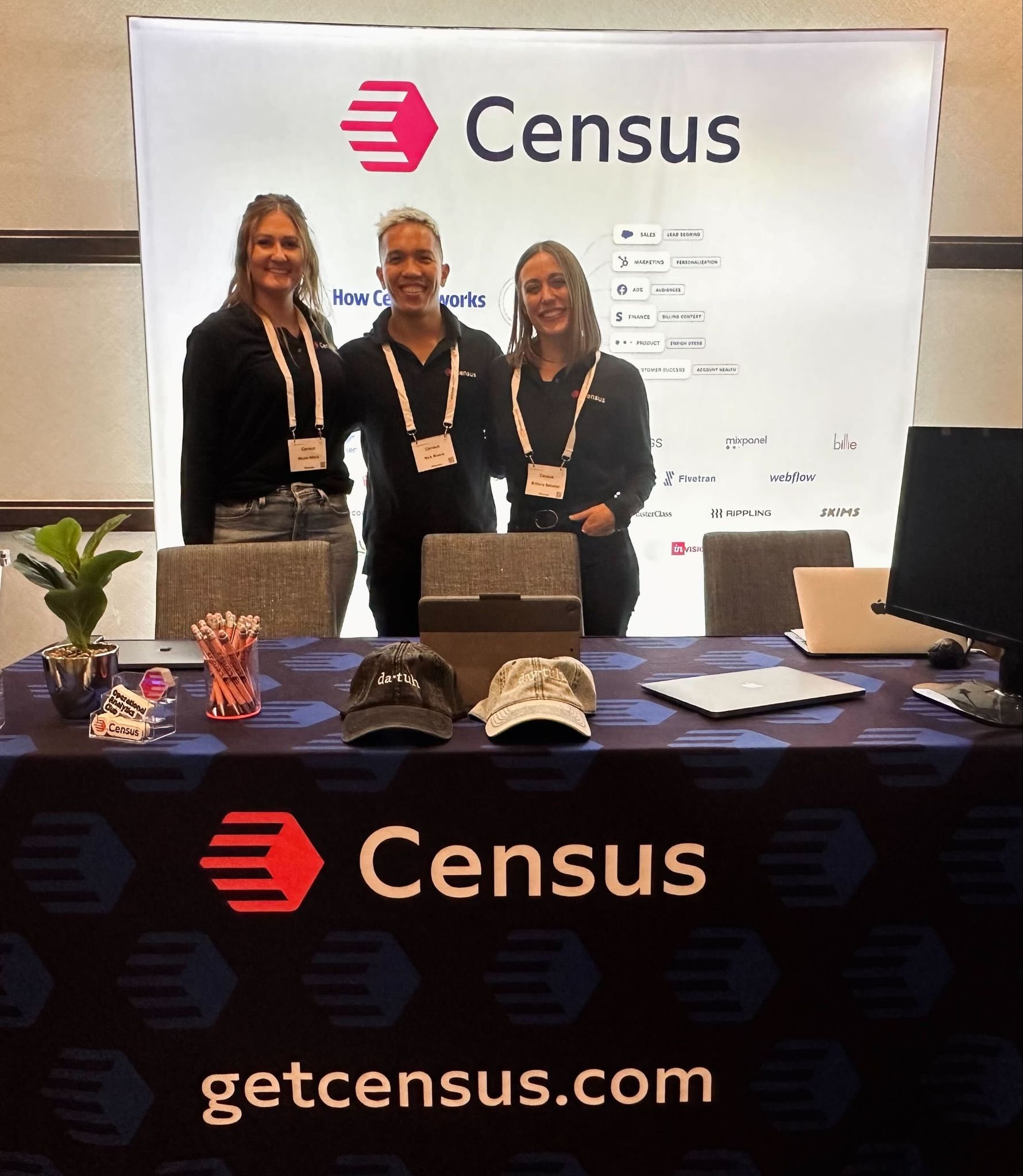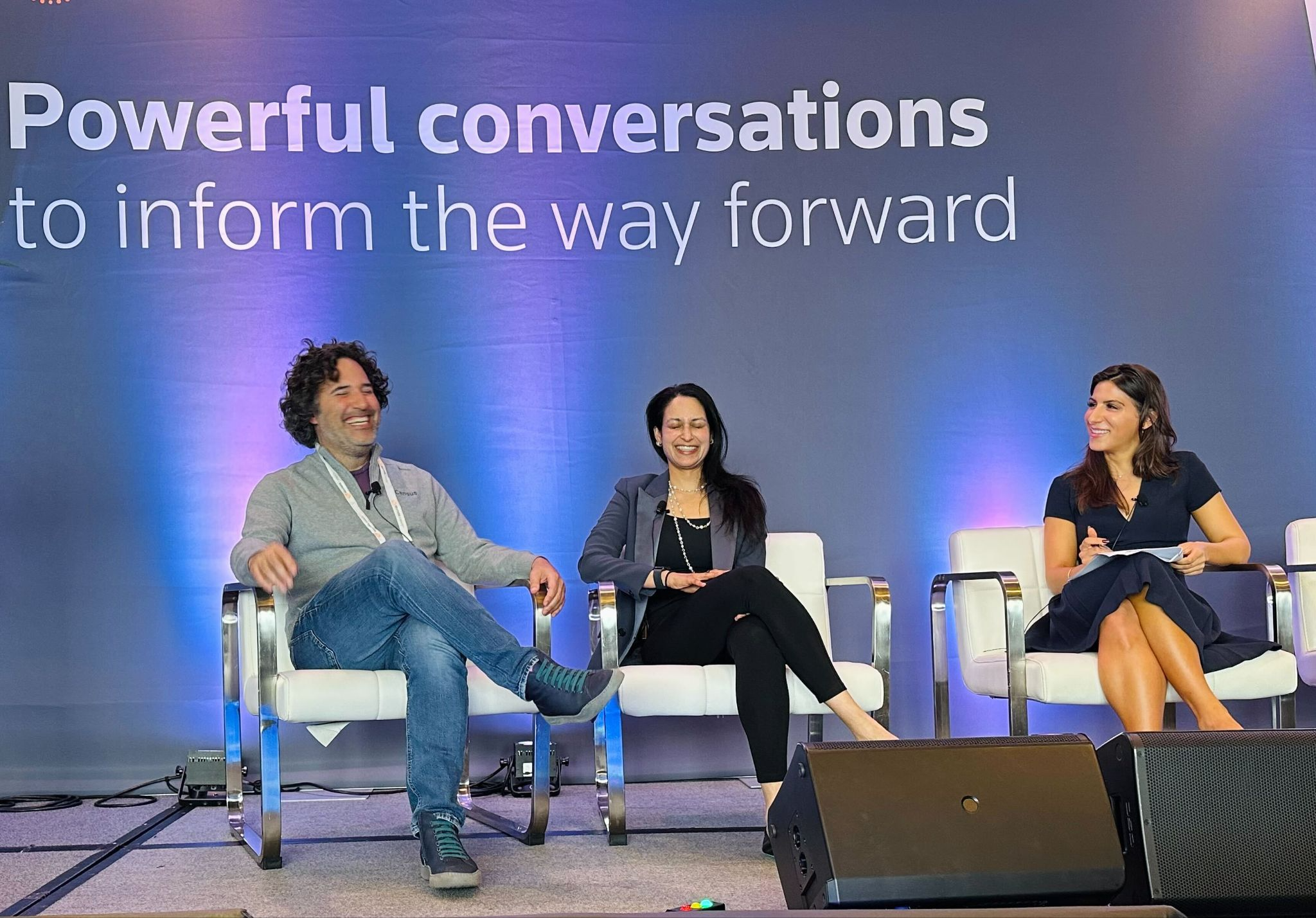Welcome to the intricate world of marketing, where authentic storytelling, technological innovation, and strategic data utilization have emerged as cornerstones of successful marketing strategies.
And, unsurprisingly, these were all key topics discussed at last week’s Reuter’s Strategic Marketing Conference. Held at the Hyatt Regency Mission Bay Spa And Marina in San Diego, CA, it was star-studded with high-level marketing executives from brands like Jeopardy, Nike, and even Chipotle. 🤩
Lucky for me, I had the pleasure of listening to some of these industry leaders spill their marketing secrets. While I spent a good amount of time working the Census booth (check us out below!), I also had the pleasure of sitting in on some of the most attention-grabbing sessions to find out what’s-what.

|
From leveraging influencers and ambassador programs, through navigating your martech stack, to unlocking valuable first-party data insights, I listened to some of the world’s top CMOs distill their wisdom, providing valuable insights and actionable strategies for marketers seeking to thrive in this complex and exciting landscape. Here are some of the top sessions and what I took away from them.
Day One
To start the conference strong on day one, I decided to go heavy into Track 1: Brand loyalty, community, and purpose. And it all started with an executive panel featuring:
- Christopher Connolly, SVP, Chief Marketing Officer, San Diego Padres
- Leah Chandler, Chief Marketing Officer, Discover Puerto Rico
- Don McGuire, Chief Marketing Officer, Qualcomm
- Adrian Fung, Global Chief Marketing Officer, eBay
Cultivating community: Loyalty that lasts a lifetime
In a world where brands are vying for consumer attention, building a loyal fanbase is more than a marketing strategy—it's a survival tactic. In a session moderated by Sofia Gerrard of Reuters Events, Christopher, Leah, Don, and Adrian shared their insights on how to foster brand loyalty and cultivate community.
Transforming consumers into lifetime fans
Leah Chandler from Discover Puerto Rico emphasized the importance of consistency and continuity in branding. By repositioning a brand around a unique product identity and consistently delivering quality, businesses can foster a sense of trust and loyalty in their audience.
Similarly, Qualcomm's Don McGuire stressed the importance of a 360-degree perspective. By engaging with consumers and incorporating their feedback, brands can demonstrate that they value customer input, fostering a reciprocal relationship where both the brand and community feed each other.
Meanwhile, Christopher Connolly of San Diego Padres and Adrian Fung of eBay emphasized the role of early engagement and authenticity, respectively. Christopher shared that engaging consumers early in their careers fosters lifetime loyalty, as their brand experience evolves with their personal growth.
Adrian also highlighted the importance of authenticity in eCommerce, where transactions can often feel impersonal. But by genuinely understanding and incorporating community feedback, brands can build a community of passionate enthusiasts.
Community-led initiatives that resonate
Successful community-led initiatives center around open communication, trust, and mutual growth. Don illustrated this through Qualcomm's practice of involving their community in product development, which instills a sense of ownership and loyalty. Leah echoed this sentiment, sharing Discover Puerto Rico's strategy of evolving their content based on social feedback to stay attuned to changing consumer sentiments.
Authenticity, as per Christopher and Adrian, starts with understanding how the community communicates with each other. Cultivating relationships empowers brands to build trust and leverage the community's voice to tell their own stories.
Creating an emotional investment among consumers
When it comes to generating emotional investment, the executives agreed on the power of partnerships and human connectivity. Don suggested cross-pollination with partners to leverage not only their own fans, but also their partners'. Christopher, on the other hand, advised brands to use social media to humanize their brand, giving consumers a peek "behind the curtain." 👀
For instance, the San Diego Padres recently started a tradition where each game’s MVP gets to wear a silly sombrero in the locker room. 🤠 It might seem trivial, but the fans are going nuts for it because they feel like they’re getting an exclusive glimpse of the real players.
Adrian focused on the role of human connectivity in creating emotional investments. Listening to their community and helping to tell their stories means brands build a deeper, more meaningful relationship with their audience.
Staying relevant in a dynamic landscape
Leah suggested a future-focused approach to stay relevant. Exploring new ways to connect with audiences outside the norm helps brands can keep their messaging fresh and engaging.
Ultimately, this session highlighted the shift from transactional relationships to more meaningful, community-centered engagements, setting the tone for the future of strategic marketing.
The power of authentic storytelling
Alongside the digital transformation takeover, the landscape of brand narratives is continuously and dynamically evolving. This metamorphosis is not merely about keeping pace with the latest technology, but about reimagining the manner in which we weave and share the stories that define our brands.
But as we navigate this terrain, we often find ourselves in the midst of a narrative revolution – one that shifts focus from traditional, one-directional storytelling to creating immersive, interactive, and authentic experiences. This is exactly what the next session I attended covered. It featured some powerful executives, including:
- Ryan Ostrom, EVP, Chief Marketing Officer, Jack in the Box
- Jim Hoey, VP, Head of Marketing, Logitech G
- Thao Ngo, SVP, Marketing, Uptempo
- Maya Wasserman, Head of Marketing, Personal Entertainment & Home Entertainment, Sony Electronics
Authentic storytelling: A customer-centric approach
To start things off, Thao Ngo from Uptempo and Maya Wasserman from Sony Electronics both emphasized the importance of customer narratives. They advocated for a storytelling approach that not only shares the brand's voice but also amplifies the stories that customers want to tell.
Logitech G's Jim Hoey added an interesting perspective, likening athletes to original influencers. Their unique stories and emotional connections can inspire consumers and deepen their relationship with the brand.
Ryan Ostrom from Jack in the Box highlighted the crucial role of influencers in authentic storytelling. For him, authenticity comes from embracing the brand's true essence and communicating it honestly to the audience. As he put it, “Jack in the Box is drunk people's food. We know it and we own it.” 👏
The Power of Emotion and Cultural Relevance
Speaking to the old adage "purchase with emotion, justify with logic", Jim underscored the significance of the emotional brain in decision-making. He suggested that marketers aim to evoke specific emotions that align with their brand's identity and observe how it resonates with the audience. Ryan echoed this sentiment, again urging brands to live and breathe by their true identity.
In terms of cultural relevance, the panelists stressed the importance of moving with the times and staying attuned to current trends. They advocated for live marketing operations that are engaging, unscripted, and interactive, as people seem to be growing weary of traditional webinars.
Authenticity and risk: Two sides of the same coin
Maya shared a bit about Sony Electronics' ambassador program that partners with high-level music artists and authentic Sony fans to tell stories from their point of view. This strategy represents a delicate balance between top-down and bottom-up storytelling that aligns with the brand's values, audience, and business goals.
But the panelists all agreed that authentic storytelling often involves risks, advising brands to have a crisis management plan in place and to protect their core values. To try and minimize these risks, they suggested setting clear boundaries and understanding the core audience to prevent any substantial deviation from the brand's identity.
Collaborating with influencers: A delicate balance
The panelists stressed the importance of giving influencers creative freedom while setting them up for success. They highlighted the need to educate business teams that the brand cannot dictate what influencers say, but rather should allow them to create their narratives in alignment with the brand's values.
They also drew attention to some high-profile missteps, like the controversy surrounding the replacement of Alex Trebek on Jeopardy, which emphasized the importance of considering how influencers connect to other organizations.
Measuring success and ROI
The panelists agreed that there's no single way to measure the success of authentic storytelling. Alignment and education were identified as critical factors, with an emphasis on the strategy driving sales as a key measure of success. They also underlined the value of partnerships that can create authentic narratives, especially those timed around key launches to generate buzz.
Ryan’s candid take on the Bud Light scandal provided a poignant reminder of the risks associated with brand storytelling. Every so often, a marketing scandal like this happens, and it’s a real reality check for brands, emphasizing the importance of authenticity and crisis management in modern marketing strategies.
Day Two
On day two, I wanted to switch things up, so I hopped over to Track 2: Data Connectivity and Creativity. To kick things off, I went to a presentation given by Drew Kurth, who owns Growth and Strategy at HCL Software.
Thriving in the martech jungle: Making sense of your martech stack
In the martech space, appearances can be deceiving. From the outside, a martech stack might seem sleek and sophisticated. But according to Drew, underneath that polished exterior lies a dense, complex jungle. CMOs, he remarked, are growing weary of empty promises of perfection, craving instead practical solutions that deliver results.
The martech ecosystem is vast and, believe it or not, the average F100 enterprise boasts over 120 martech solutions in their stack. 🤯 This complexity can be daunting, but Drew offered strategies to optimize the use of these existing solutions, focusing on three core aspects: Data generation, campaign execution, and personalization.
Data generation: Turning raw data into valuable insight
Marketing activities generate a wealth of data. Drew suggested implementing preset standards to harness this data effectively, like a data warehouse or a data lake.
Side note: He even mentioned a new phenomenon known as a data boathouse, so if anyone knows anything about this, please fill me in. 😂
Campaign execution: Planning for future analysis
Campaign execution standards and contact history are integral components of a robust martech strategy. Drew recommended designing the execution structure of campaigns with future analysis in mind, prompting marketers to question how they initiate campaigns, how they roll up campaigns for reporting, and how they view results across different campaigns.
Personalization: Meeting consumer expectations
Despite consumers expressing a strong desire for personalization, with 71% expecting personalized experiences, only 18% report being very satisfied with the current level of personalization they receive. Te solution to this personalization challenge, as Drew noted, lies in recognizing patterns and using existing data effectively.
For location-based personalization, Drew advised selecting profile criteria, setting location parameters, and identifying fields for personalization. Considerations for such patterns include personalization parameters, common marketing intent or objectives, common inputs like audience or location, and common outputs such as a mobile app or email.
Ultimately, defining and clarifying personalization patterns allows marketers to streamline their approach and meet consumer expectations more effectively.
Drew's presentation offered valuable insights into the intricacies of managing a martech stack, highlighting the need for a strategic, data-driven approach to marketing operations. And, even better, this presentation segued seamlessly into the next session (which just so happened to be a panel featuring Census’s own Co-founder and CEO, Boris Jabes), further exploring the importance of personalization in martech.
Map a 360° view of your customer: A deep dive into data
When it comes to customer data, blind spots are a marketer's worst enemy. But a 360-degree view of the customer is a holistic approach that exists to break down any and all business unit silos to remove every customer data blind spot.
But how, exactly, do you achieve that? Luckily, the next panel engaged in a riveting discussion on how to create a comprehensive, usable customer profile and unlock valuable first-party data insights. The two members of the panel were:
- Radhika Duggal, Chief Marketing Officer, Super.com
- Boris Jabes, Co-Founder and CEO, Census
Besides revealing actionable insights, they also had a few good laughs. Just look at those smiles! 😄

|
The difference between average and world-class 360-degree view
An average 360-degree view, according to Boris, is often the product of a single team within a company, such as the performance marketing or consumer insights team. This approach typically results in a narrow perspective of the customer, based on a limited set of attributes. In contrast, a world-class 360-degree view encompasses everything a business should know about a customer, including interactions across various SKUs and product lines. Trust, Boris argued, is the most significant missing component in many 360-degree customer profiles.
Stakeholder involvement: The key to comprehensive insights
To eliminate silos and enhance understanding of the customer, Rhadika stressed the importance of involving all stakeholders who interact with customers in the creation of the 360-degree view. Reflecting on the journey of Super.com, she highlighted how the company pivoted its business model twice based on data insights, ultimately developing 'Super Pay' to accommodate the payment preferences of their customer base.
Boris offered a case study from Canva, where the data and analytics teams used Census to capture comprehensive customer information, differentiating between regular users and 'super fans.’ This approach facilitated a more seamless relationship between the data and marketing organizations and optimized campaign efficiency.
Customer 360 tips
As for something the audience members could implement on their own, Boris suggested the use of AI. With the help of trusted data, AI can optimize a business's user base over time, addressing the often overlooked time component in Customer 360. As a bonus, it can also help bridge the communication gap between data teams and marketers by generating explanations for data findings.
And Rhadika encouraged businesses to simply start, try, and not be afraid. Boris agreed, describing the Customer 360 as a process rather than a fixed state, and stressed the importance of trust in data.
The importance of focusing on the journey
Finally, when discussing what many companies get wrong about the Customer 360, Boris pointed to the historical focus on optimizing for a single transaction. He urged businesses to shift their focus to the customer journey as a whole, emphasizing that it's not about a single channel or moment but rather an ongoing, authentic experience. As he succinctly put it, "Be good stewards and let data drive a better experience."
📺 Want to hear more from the conference? On-demand recordings of each session will be available here.
🏆 And if you want to learn more about how Census can help you achieve a world-class Customer 360, book a demo with a product specialist.

















